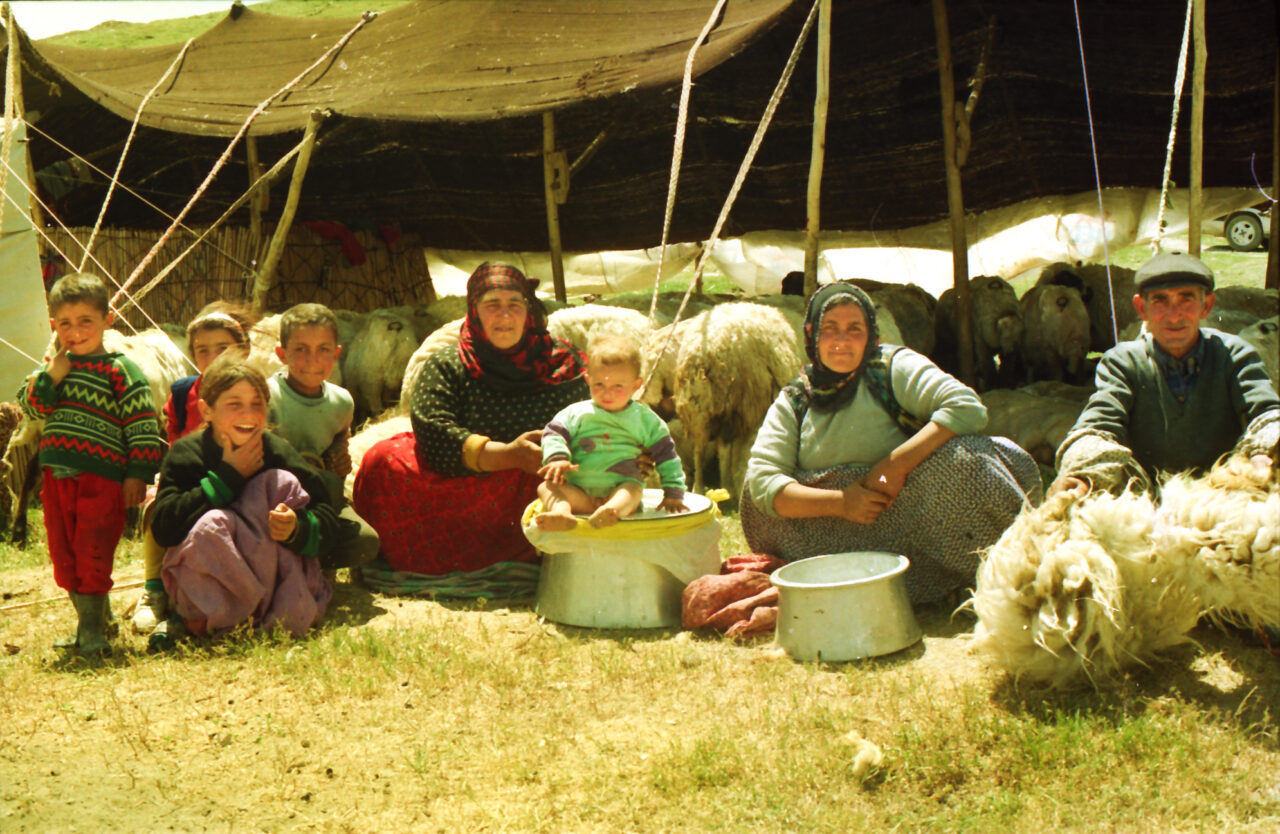
As a result of its climate and geographical setting, animal husbandry has been a significant production activity in Diyarbakır and its environs in all periods of history. This is first and foremost an economic activity, an important means of livelihood. In addition to large and small ruminant breeding, the diversity of animals in the region also means that a wide spectrum of products are manufactured. Although changes in everyday life have had an impact on traditional methods, there are still those who do not give up on practicing ancient methods, each a unique craft. For instance, the göçer/koçer, continue their life-styles despite a few changes, and especially with the contribution of the older generation, keep such methods alive. It is again the nomadic göçer who keep alive the aspects of animal husbandry that render it, as much as an economic activity, a way of establishing a bond with nature and life, and a culture in itself.
This is why, in this section, we do not only examine the economic aspect of animal husbandry, but also include records and first-hand accounts compiled from individuals who are part of this culture.
Diyarbakır has been an important city of the Mesopotamia region since ancient periods, and it has never lost its importance since its foundation. In addition to its historical, political and cultural aspects, we see that the city also stands out in terms of animal husbandry, both for its production and unique genetic sources.
In the late period of the Ottoman Empire and the early years of the Republic, the animal husbandry industry was a field that helped increase the welfare level of the section of society that made a living through agriculture and livestock breeding. Large land size and low population density rendered animal husbandry a profitable industry.
A census of agriculture held in Diyarbakır province in 1909 records 58,683 beef cattle, 46,797 draft oxen, 3,034 water buffaloes, 3,350 draft buffaloes and a total of 111,864 large cattle. The same census records 412,339 sheep, 252,285 hair goats and a total of 664,624 small ruminants. The existence of working and draft animals used to be more prominent then, however, they lost their importance with the rise of mechanization. The census further records 40,977 donkeys, 8,525 horses and 4,826 mules, making up a total of 54,328 working and draft animals across Diyarbakır. The high number of horses is related not only to transport and carriage but also with the low draft capacity of draft oxen in the region.
According to the agricultural census of 1927, there were 33,148 cows, 9,852 heifers, 14,095 calves, 5,540 fawns, 2,058 female water buffaloes, 532 water buffalo heifers and 436 buffalo calves, 109 buffalo bulls, 1,439 camels, 139,914 sheep, 150,142 hair goats, 707 angora goats, 100,546 chicken and roosters, 6,466 turkeys, 807 geese and 119 ducks in Diyarbakır, and as draft animals, 36,966 oxen, 3,185 buffaloes, 958 horses, 1644 mares and 541 mules under record.

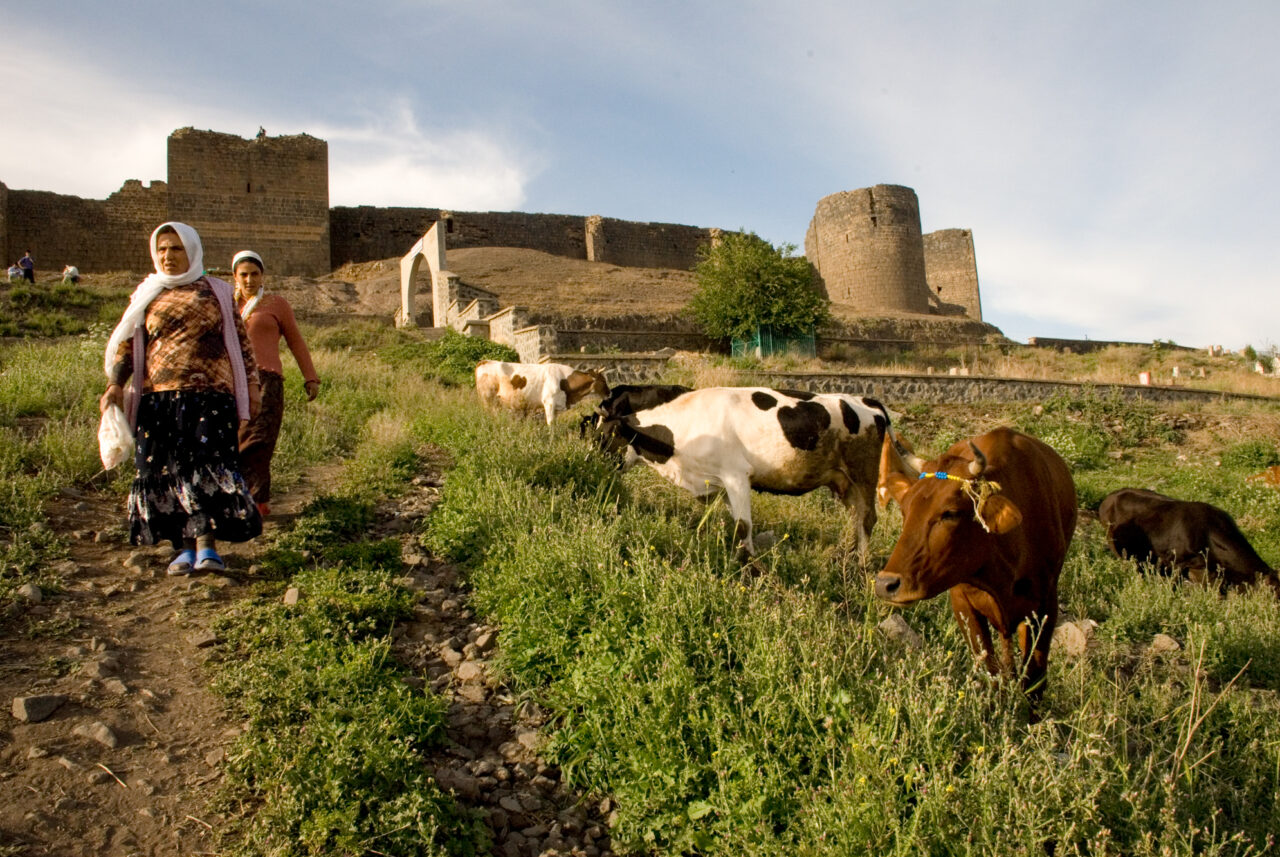
According to 2020 data, Diyarbakır holds second-place in Turkey with 16, 704 water buffaloes. Water buffalo milk is a valuable product, and breeders produce water buffalo yoghurt for the domestic market.
According to most recent data, the city has a total of 639,370 cattle, with 108,823 special breeds, 371,204 crossbred cattle and 159,343 local cattle. The milk they produce is processed at the 18 dairy products processing facilities to make yoghurt, ayran, cheese, butter and ice-cream, and these products are presented to consumption in the domestic market and neighbouring provinces. Yoghurt made in traditional copper buckets known as sitil are also highly popular.
The Diyarbakır Agricultural Specialization (Livestock) Organized Industrial Estate, the first of its kind in Turkey, continues its activities with 82 separate animal husbandry businesses in a total of 103 lots. Meat produced here is processed at six meat processing and packing plants and presented to the market.
According to 2020 data, there are a total of 2,091,344 sheep and goats in Diyarbakır. 417,763 of them are hair goats, 1,673,303 of them are local sheep and 278 are merinos sheep.
Sheep’s and goat’s milk produced in the spring and summer period are used in making yoghurt, butter and cheese. Örgü peyniri [lit. ‘plaited cheese’], a geographically designated product made of sheep’s and goat’s milk, is one of the most important products of the city. Made either of sheep’s milk or a mixture of goat’s milk and cow’s milk, Diyarbakır’s örgü peyniri resembles kaşar cheese in terms of its production stages, however, it stands out with its unique aroma, creamy white colour and shiny texture.
The sheep and goat breeding industry of Diyarbakır is home to two important genetic sources, the Zom sheep and the Mahalli goat. Zom sheep are raised in the Karacadağ area. Zom is a sheep variety that has adapted to the rough and rocky terrain of the area and the dry and hot climate, it is resistant to disease and parasitic infections, has great grazing ability and strong herd instincts. The Zom sheep is beige or white-creamy and has black spots on its head and around its mouth, eyes, tail and legs. Research and studies for a breed registration continue.
The Mahalli goat is a local genetic source raised in the Karacadağ area. Well-adapted to the region, it is a goat variety with spiral horns extending to the side with almost no distance between the stems of the horn. Strong leg structure and thick lower hair set the Mahalli goat apart from others. The GAP Uluslararası Tarımsal Araştırma ve Eğitim Merkezi [GAP International Agricultural Research and Training Centre] continues its studies on this variety.
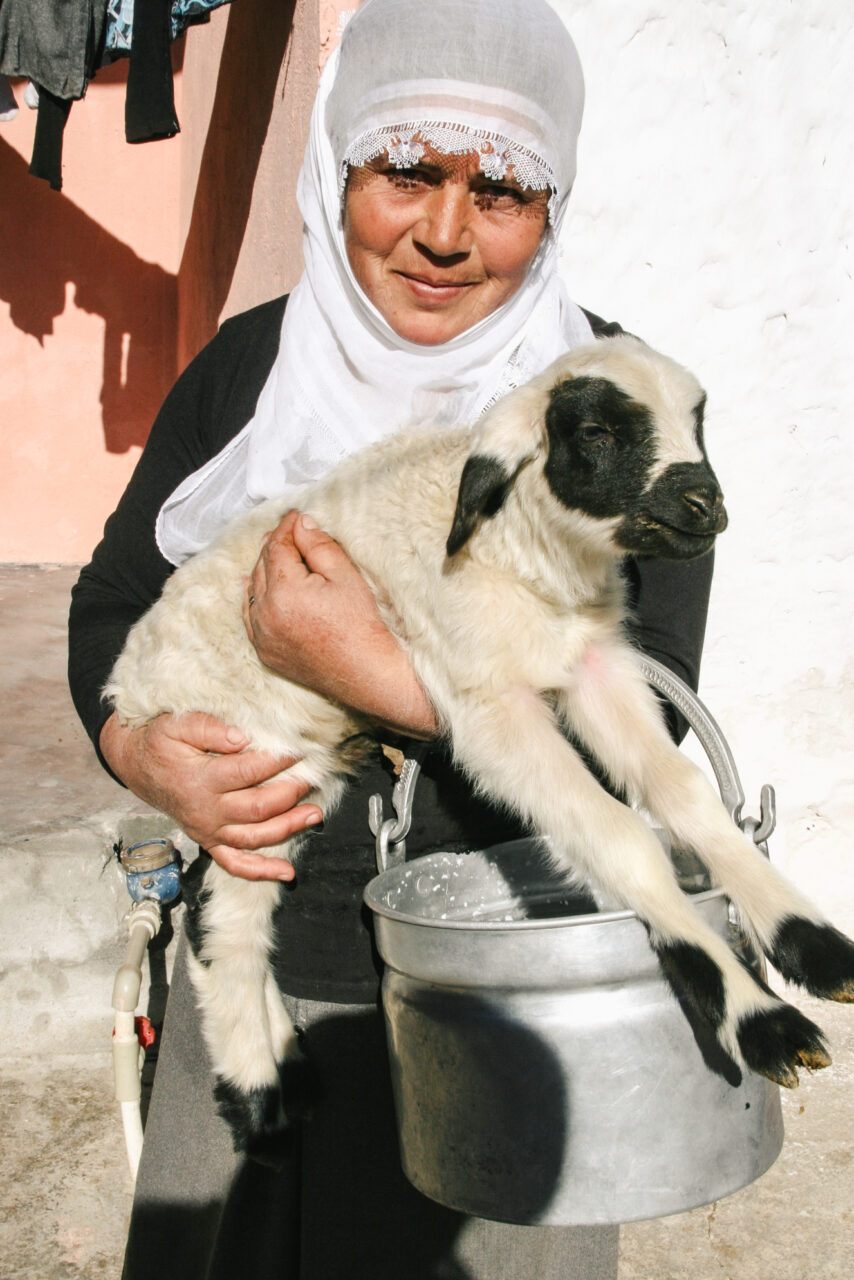
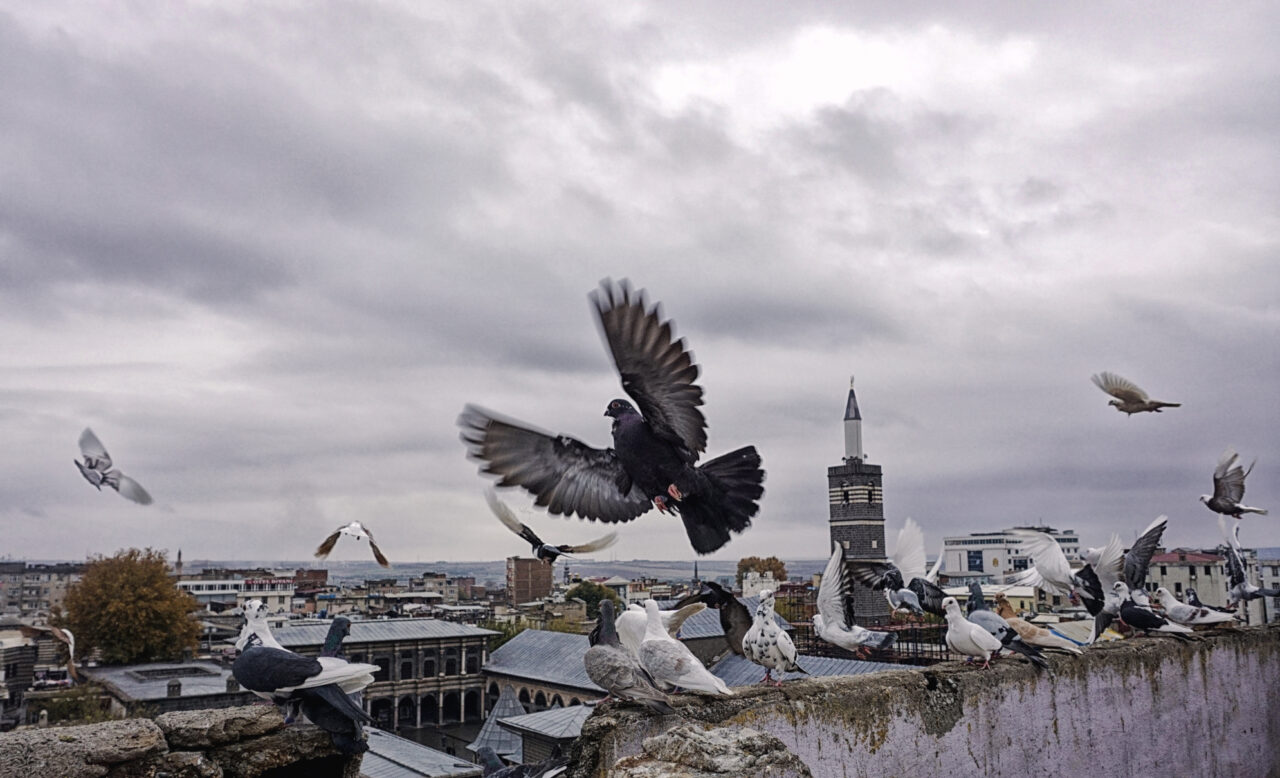
As for other animals raised in Diyarbakır, data from 2020 provides an overview. Diyarbakır has a highly suitable climate for sericulture. (“The city wrapped in silk”) Diyarbakır is also a leading city in the region in terms of apiculture, with 115,630 bee hives. A total of 1,306,556 poultry includes 207,631 turkeys, 121,354 geese, 25,279 ducks, 73,261 broiler hens and 879,031 layer hens.
Diyarbakır is also a leading city in pigeon breeding, and there are pigeon cotes known as boranhane in various parts of the city. Four species of pigeons are prominent here: Kızılbaş, Göğsüak, Ketme and İçağlı. There are five colour varieties of the Kızılbaş species, and six colour varieties for the Göğsüak, Ketme and İçağlı species. Black pigeons are called Ketme atlas in the Ketme species, Atlas in the Göğsüak species, Zengi in the İçağlı species and Karabaş in the Kızılbaş species. Yellow pigeons are called Bozak in the Ketme species, Narinci in the Göğsüak species, Tahini in the İçağlı species and Sarıbaş in the Kızılbaş species. Red pigeons are called Ketme ciğeri in the Ketme species, Ciğeri in the Göğsüak species, Gümüşkuyruk in the İçağlı species and Kızılbaş in the Kızılbaş species. Sky-coloured pigeons are called Ketme gögala in the Ketme species, Gögala in the Göğsüak species, Kara in the İçağlı species and Mavibaş in the Kızılbaş species. The size and taste of Diyarbakır watermelons grown at the Hevsel Gardens using manure obtained from the boranhane is also of particular note.

Until the 1960s, in the field of sociology in Turkey, nomadism and its culture was not a widely studied subject. After all, no study could focus on nomadic Kurdish tribes because of official ideology. A pioneer in the field, İsmail Beşikçi completed his thesis in 1967, and his book titled Doğu’da Değişim ve Yapısal Sorunlar: Göçebe Alikan Aşireti [Change and Structural Problems in the East: The Nomadic Alikan Tribe] was published in April 1969 in Ankara, by Doğan Yayınevi [Doğan Publishing House]. The book would be reprinted in August 1992 by Yurt Kitap-Yayın. In his preface, Beşikçi writes, “It was in the summer months of 1961, during my practical training period that I first met Kurds”. In the editions of the book made in the 2000s, Beşikçi comments on Kurdish presence, denied during that period, also adding his views that changed over the years. Beşikçi’s study on the nomadic Kurdish tribes remains relevant today. Beşikçi discusses many aspects of this culture where animal husbandry plays a significant role, and the way in which the love of nature has become part of everyday language, and is reflected in proverbs is one such aspect.
“In nomadic culture, horse and sheep culture is highly developed. Therefore, there is a great love for animals, and especially towards these two species. The nomads love these animals dearly. They care for their health more than their own. Riding horses and understanding sheep are two areas where every nomad has to faultlessly master and practice. The love of nature and animals, and the culture that it has created is so strong that many proverbs used in everyday life are related to these:
- If you don’t want to have nightmares, don’t sleep in the deep stream.
- The sheep is either on this side of the water, or on the other side.
- The billy goat may approach the sheep on the sly, but the sheep gives birth in the open.
- An assembly full of ignorant people is bound to be noisy, and the same goes for a herd with a donkey in the middle.”
Source: İsmail Beşikçi, Doğu’da Değişim ve Yapısal Sorunlar: Göçebe Alikan Aşireti [Change in the East and Structural Problems: The Nomadic Alikan Tribe], İsmail Beşikçi Vakfı Yayınları, 2014.

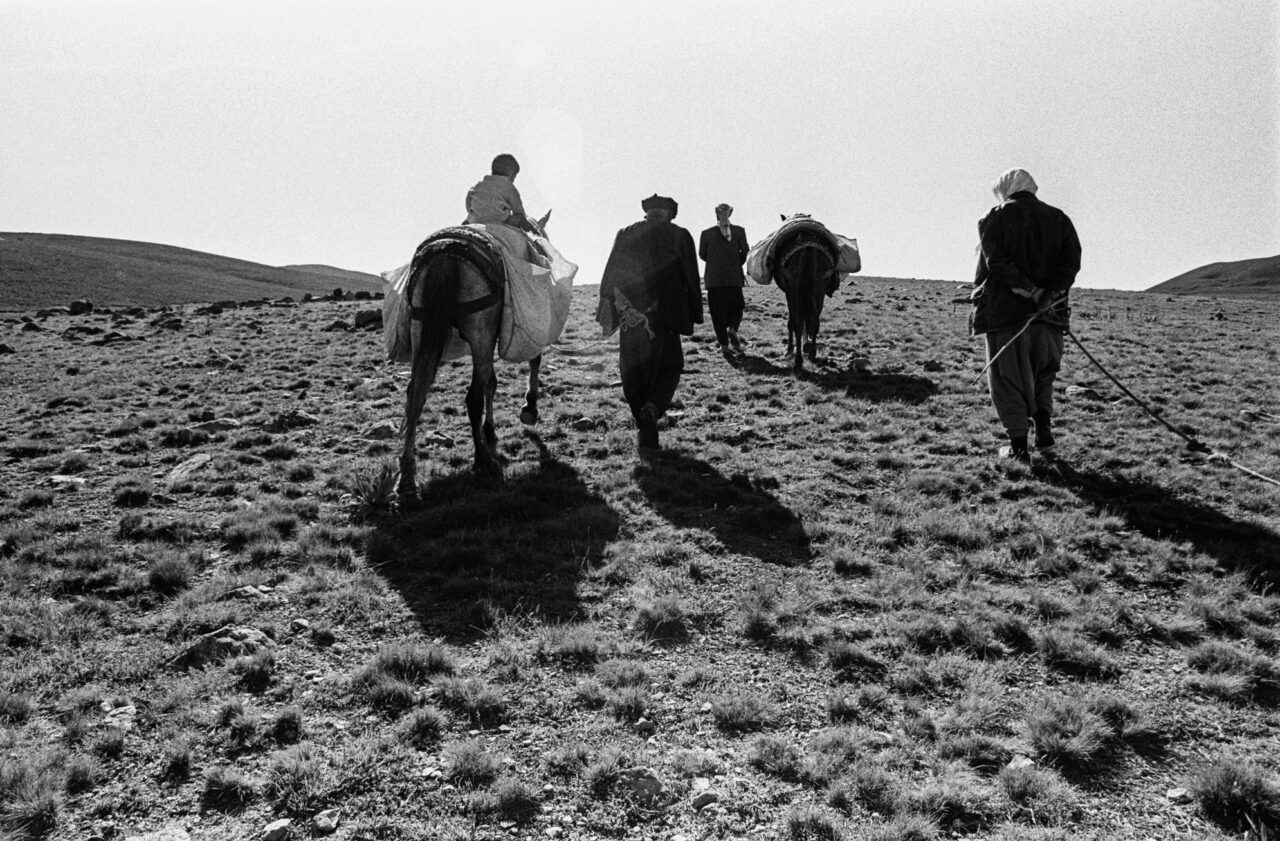
“The horse and the mule are among the most important elements of the nomadic way of life. They are meticulously cared for and used for no other work other than the migration itself. A nomad does not rent out animals, even if it is in return for money. One day (in the summer of 1964), Abidin İnan, son of Sheikh Selahattin, the district governors of Ahlat and Adilcevaz and some of their friends want to ascend Mount Süphan. They come by car to the skirts of the mountain. There, a zoma¹ of 35-40 tents from the Alikan Tribe have set up camp. The governors and their friends rest at Örengazi, a village on the skirts of the mountain. There, they send the village head to the zoma of the nomadic tribe. The wish of the governors is to climb the mountain on mule back. When he arrives at the zoma, the village head sees no men in the tents. There, he goes up to the women, tells them that he is there on the wish of the governors, that they want mules to climb the mountain and that they must be given to him at once. The woman he speaks to is unperturbed. ‘We only use our mules to carry our load during migration. At other times, even we don’t use them’ she says. The village head insists, however, the woman pays no attention whatsoever. The village head returns to the village and explains the situation to the governors. Then, Sheikh Selahattin’s son Abidin İnan, a man of great authority, visits the tents. He states that he is Sheikh Selahattin’s son, that he wants to climb the mountain and that he needs three or four mules. The women remain unflustered. ‘Let alone the Sheikh, you could be the son of Owais al-Qarani and we still wouldn’t give you our mules’ they say.
(This incident was recounted by Village Head Ahmet Ağa in Örengazi village in July 1965. A few months later, the incident was verified by Ahlat District Governor Mecit Sönmez, who was part of the story, and Deputy Governor of Erzincan at the time when the story was told.)”
Source: İsmail Beşikçi, Doğu’da Değişim ve Yapısal Sorunlar: Göçebe Alikan Aşireti [Change in the East and Structural Problems: The Nomadic Alikan Tribe], İsmail Beşikçi Vakfı Yayınları, 2014.
¹ Zoma: Term describing the gathering of a few families in nomadic culture.
“I was born in the Hecî Koç (Köstekli) village. I am 59 years old. We were children, we used to go to the mountains and the slopes to graze the cows and the goats. When we grew up a little, we began to do the housework. We also went to mow grass with the sickle. We would trail those who mowed with the scythe, collect what they had done and tie it up. We would load the grass onto camels and bring it home. We would plant rice, carry the harvest and thresh and pile. We would wrap up all the grass and bring it back for the animals.
We used to come to collect geven [astragalus, milkvetch] for the large cattle and the sheep. We would get up at midnight, our mother would prepare a camel’s load for us. She would fit the saddle, tie the reins and put in our food as well. We would go to the valleys as the world was only just lighting up. Everyone would come in twos. One would collect, the other would bundle the shrubs. We would place some on one side of the camel, and some on the other side. We would rest the camels halfway, then load them up again and return. We would carry geven at night for a month.
We have been coming to this particular highland ground for twelve years. We used to come in the past as well, but we had goats, we were lower down. Now we have sheep, they need more space, they need to be comfortable. So we go higher up. It is rocky and steep around us.
In the past, before they went to the highlands with their camels, they would prepare, they would renew all the ropes. They would mend the torn tents. They would leave nothing behind in the houses. They didn’t have much. They would pack up all their bedding and provisions onto animals and bring it here. They would leave nothing behind.”
From the oral history recording made by DKVD with nomad Eyşan Karayün in 2021 at the Xaniyê Sor highlands in Karacadağ. Interview: Hüsamettin Bahçe
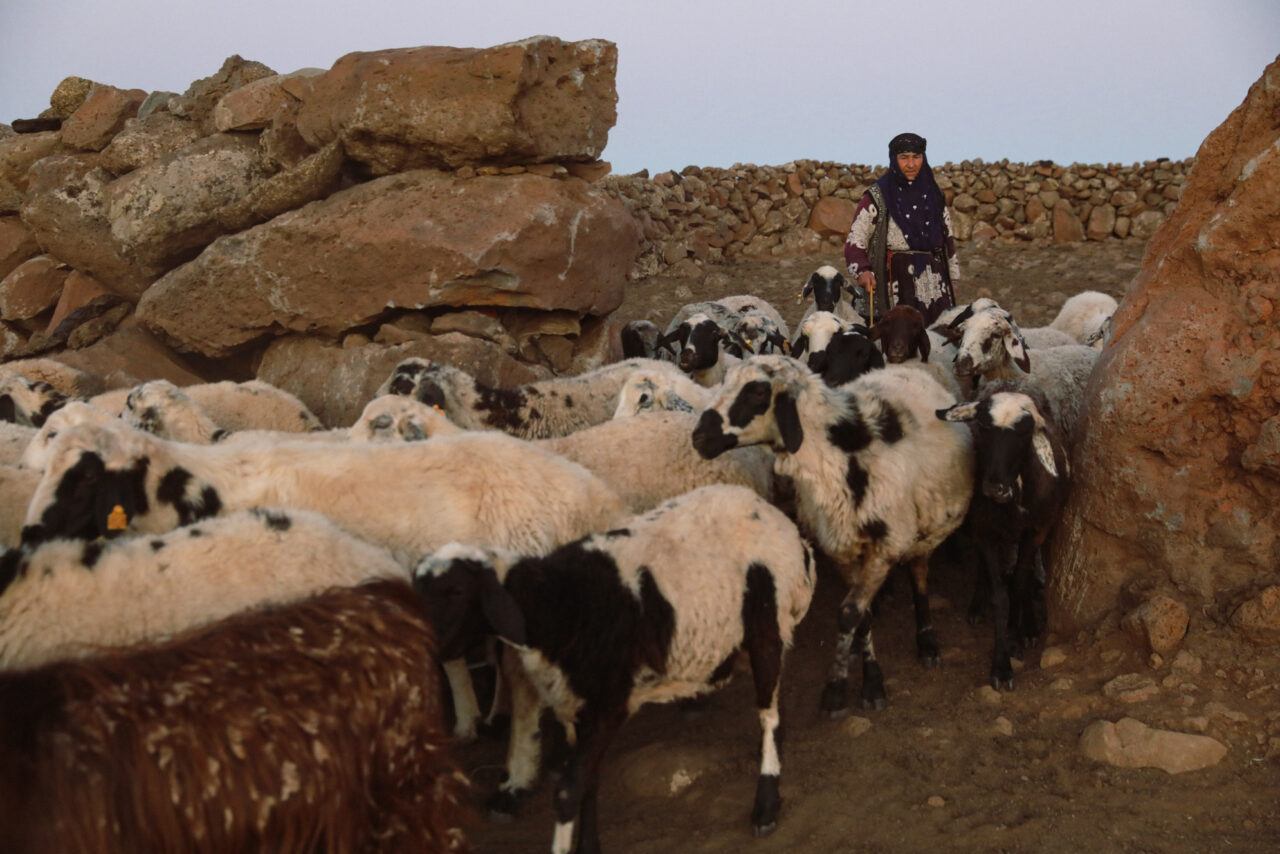

“People make more cheese nowadays. No one pays heed to old habits. It’s comfortable now, they don’t tire themselves. The old folks used to work hard and exhaust themselves.
We make two types of cheese. Both eritme and salamur [brined]. For instance, no one makes cheese in the yayık [churn] anymore. They’ve invented electrical ones, if it wasn’t for an elderly person like me, no one would make cheese in tulum [goatskin]. I do because I like to. I make ayran [a drink made of yoghurt and water]. They don’t make kurut [cottage cheese dregs] anymore, nor do they weave carpets, or use spindles. There are new means for everything, people buy them all. In the past, if you didn’t have a bag, you had to make one.
We wake up before sunrise in the morning. If our animals are in the barn, we let them out. We prepare breakfast for the shepherds, they eat and leave. We begin the housework. Some of us do the washing up, some of us bake bread. Others go to the waterside, everyone does a job.
We have to have had our own lunch before the sheep return. Sometimes, we see the shepherds arrive just as we place the food. We swiftly go to the wells, fill the troughs with water, give them water. We can only eat after we spend a little time with them. Then we pick up our milk pails and go milking. We bring the milk back and ferment it. We don’t stop until the evening.
We don’t stop until the milk products are finished. But then the animals become sterile, they give less milk, and there is less work to do. We get bored, we occupy ourselves with these strings to alleviate the boredom. In the morning, we go out to collect firewood. We help the men, line up the animals, fill up the troughs. If we didn’t have to help the men, if we only had our own work, it would be fine. My work, my bride’s work here is harder than the men’s work. And our neighbour woman’s, too. And then they still argue with us, asking us, what is it that you do. So I said, I do thousands of tasks, all you do is herd the lambs. So he says, your work is invisible. And they still argue with us.
I love the highlands, I would never desert them. I am used to the cool air. Still I can’t sleep when I go to home. We stay here for around six months. We forget about the other place. This is the place I like, the mountains, the ridges.”
From the oral history recording made by DKVD with nomad Eyşan Karayün in 2021 at the Xaniyê Sor highlands in Karacadağ. Interview: Hüsamettin Bahçe
“I was born in ’56. We are originally from here, from Textê Rast. Our tribe is the İzol tribe. We have been a göçer since 1959. We do not know what it means to stop. You know how animal husbandry is. We constantly go to Karacadağ and back. For a few years we went to Tîgme. For around 25 years we stayed at Şîlan. Şîlan is in the valley below.
This place is called Xaniyê Sor, because in the past the historical route (the old caravan route) passed through here. The xan were located along this route. Xan, meaning the place where caravans stopped over. Right behind our tents. My father’s generation saw the xan here, but we didn’t.
In the winter we go to the village. I am not bored of the nomadic way of life, it is beautiful. This area is all meadows. I mean, everyone comes to the highlands, grazes their animals, sets up their tents. It belongs to everyone, no one claims that it belongs to them. We have been nomads, since our ancestors. They all came here, to Karacadağ. Now everyone has quit, they have all settled.
In the past, there were camels, horses and donkeys. They would load up their belongings and come and set up here. Now it’s cars, of course. Everyone has a car. We have around 200 sheep. I estimate that there are around ten thousand sheep and two thousand large cattle in this area.
Our living depends on the animals. If there are no animals, then we are gone, too. The young go to Istanbul or to other places to work. We have our needs; we meet our costs with them. We send cheese and yoghurt to the city. Everyone has a shop they work with. We sell it for money. And the shopkeeper sells it on our behalf. Or we give it to friends, ‘keep some cheese for us’ they say.
How can we make do with what we sell! It’s not enough. And then we have to sell sheep, sell lambs. That’s how we make a living. We make butter. We sell what’s surplus. Our shepherd is from our family. Some bring shepherds in. Shepherds demand a certain monthly salary and they agree.
We don’t have a lot of problems in the highlands. Sometimes it rains a lot and we feel gloomy. There’s no place for the animals to shelter. The surface is wet, that’s a problem, nothing else. It was the same in the past. Since the time of our ancestors. In the past, our ancestors used to take their clothes to the fountain, make small pools and wash them there. That was where they washed themselves as well. Now they have washing machines, they send them to the village. There is solar energy now.
The old tents were made by hand. When real angora wool is woven by hand, it never drips, even if it coils up. But today’s tents drip. In the past, there were oil lamps. There was kerosene, paraffin lamps, and nothing else. Some people didn’t even know about them, they were poor. They lit fires, that’s how they made light, they ate and sat in front of the fire. They didn’t even have stoves. They had nothing.”
From the oral history recording made by DKVD with nomad Süleyman Karayün in 2021 at the Xaniyê Sor highlands in Karacadağ. Interview: Hüsamettin Bahçe
![Süleyman Karayün is a <em>göçer</em> [nomad] like his ancestors, and he talks about the difficulties of making a living today. However, he is still not tired of living a nomadic life. (Photograph: Aylin Kızıl, 2021)](https://diyarbakirhafizasi.org/wp-content/uploads/2021/11/10_hayvancilik-1280x854.jpg)
Translation: Nazım Dikbaş
BIBLIOGRAPHY
• 1927 Tarım Sayımı [1927 Agricultural Census], Devlet İstatistik Enstitüsü Matbaası, Ankara, 1970.
• Akça, N. and Bakır G. (2017) “Karacadağ Zom Koyununun Süt Bileşimi [Milk Composition of the Karacadağ Zom Sheep]”, Dicle Üniversitesi Veteriner Fakültesi Dergisi, 10(1):19-23.
• Barıtcı, İ., Adıgüzel, C. and Kanat, M. (2017) “Diyarbakır ilinde ipekböceği yetiştiriciliğinin genel durumu [General Outlook of Sericulture in Diyarbakır Province]”, Dicle Üniversitesi Fen Bilimleri Enstitüsü Dergisi, 6(2): 77-82.
• Bekleyen, A. (2007) “Diyarbakır Kırsalında Güvercin Evleri: Boranhaneler, Karaçalı (Tilalo) Köyü [Dovecotes in Rural Diyarbakır: The Boranhane, Karaçalı (Tilalo) Village]”, Trakya Üniversitesi Journal of Science, 8(2): 99-107.
• Coğrafi İşaretler ve Geleneksel Ürün Adları Başvuru Kılavuzu [Geographical Signs and Traditional Product Names Reference Guide], Türkiye Patent Enstitüsü, 2019.
• Denli, M., Demirel, R. and Sessiz, A. (2016) “Diyarbakır İli Hayvansal Üretime Dayalı Gıda Sanayisinin Durumu [Condition of the Food Industry Based on Animal Production in Diyarbakır Province]”, Iğdır Üniversitesi Fen Bilimleri Enstitüsü Dergisi, 6(1): 133-141.
• Diyarbakır İl Gıda, Tarım ve Hayvancılık Müdürlüğü 2016 Brifing Raporları [Briefing Reports of Diyarbakır Province Food, Agriculture and Animal Husbandry Directorate, 2016], 2016.
• Kumaş, N. (2021) “Cumhuriyet Döneminin İlk Yıllarında (1925-1929) Van İlinde Tarım ve Hayvancılık İstatistiklerinin Analizi [Analysis of Agriculture and Animal Husbandry Statistical Data in Van Province in the Early Years of the Republican Era (1925-1929)]”, Van Yüzüncü Yıl Üniversitesi Sosyal Bilimler Enstitüsü Dergisi, Van Özel Sayısı: 239-262 [Special Van Issue of the Van Yüzüncü Yıl University Social Sciences Institute Journal].
• Kuş, A. (2019) “Amerikalı Misyoner Southgate’in Tanzimat Öncesinde Diyarbakır’a Dair Bazı Gözlemleri [Some Observations on Diyarbakır of American Missionary Southgate in the pre-Tanzimat {Reorganization} Period]”, Dicle Üniversitesi Sosyal Bilimler Enstitüsü Dergisi, 22: 295-305.
• Osmanlı Dönemi Tarım İstatistikleri 1909, 1913 ve 1914 [Ottoman Period Agricultural Statistics 1909, 1913 and 1914], Türkiye Cumhuriyeti Başbakanlık Devlet İstatistik Enstitüsü, Ankara, 1997.
• Öğüt, T. and Çadırcı, Ç. (2013) “Cumhuriyet Dönemine Geçiş Sürecinde Diyarbakır’da İktisadi-Mali ve Sosyal Yapı [Diyarbakır’s Economic-Financial and Social Structure in the Transition Period to the Republic]”, Akademik Bakış, 7(13): 141-170.
• Quataert, D. (1999) Osmanlı İmalat Sektörü, [Ottoman Manufacturing in the Age of the Industrial Revolution] translated into Turkish by Tansel Güney, İletişim Yayınları, Istanbul: 74.
• Saygılı, D., Demirci, H. and Samav, U. (2020) “Coğrafi İşaretli Türkiye Peynirleri [Cheeses of Turkey with Geographical Designation]”, Aydın Gastronomy, 4(1): 11-21.
• Tuncer, O. C. (2001) “Diyarbakır Kenti Kimliği [Diyarbakır’s Urban Identity]”, I. Bütün Yönleriyle Diyarbakır Sempozyumu [Diyarbakır in all its Aspects, Symposium I] (27-28 October, 2000), Diyarbakır Tanıtma, Kültür ve Yardımlaşma Vakfı, Ankara: 164-175.
• Yılmaz, O., Savaş, T. and Ertuğrul, M. (2012) “Batman, Diyarbakır, Mardin Ve Şanlıurfa İllerinde Güvercin Yetiştiriciliği Kültürü, Kimi Sorunlar Ve Çözüm Önerileri [Pigeon Breeding Culture in Batman, Diyarbakır, Mardin and Şanlıurfa Provinces, Certain Problems and Solution Proposals]”, Harran Tarım ve Gıda Bilimleri Dergisi, 16(1): 49-53.


